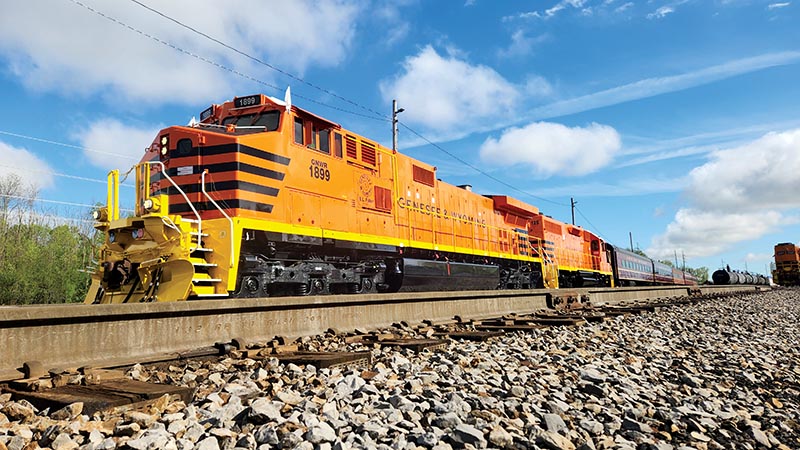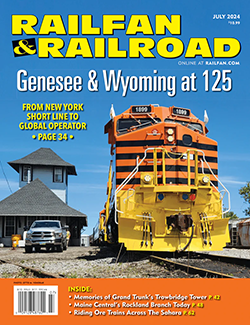 by Otto M. Vondrak/photos as noted
by Otto M. Vondrak/photos as noted
A survey team drilling for oil discovered large salt deposits around New York’s Wyoming County in 1878. Geologist Carroll Coker surmised that large pockets of salt could be found in neighboring Livingston County along the shores of the Genesee River, a worthwhile investment for any financier. Genesee & Wyoming Valley Railroad was incorporated in 1891 to haul out mined rock salt to interchange with other railroads in the region. Business grew, and the line was later reorganized as Genesee & Wyoming Railway and purchased by Edward L. Fuller in 1899 (his family had previously purchased the salt mine in 1895). The operation at Retsof, N.Y., would grow to become one of the largest rock salt mines in the world, creating a steady stream of lucrative traffic for the railroad for decades to come.
The 14-mile railroad proved to be a good investment for the Fuller family throughout the 20th century, with a low operating ratio and nearly no debt. The short line was also able to take advantage of several competitive connections for interchange, having its pick of Baltimore & Ohio; Delaware, Lackawanna & Western; Lehigh Valley; and Pennsylvania Railroad.
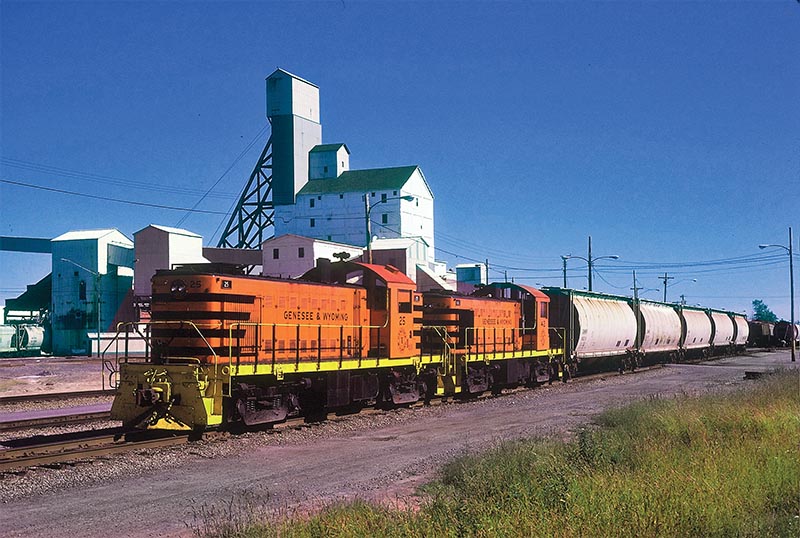
ABOVE: GNWR Alco RS-1s 25 and 42 (ex-New Haven 0670) switch out hoppers at the original salt mine in Retsof, N.Y., on June 24, 1985. —Bob Todten photo
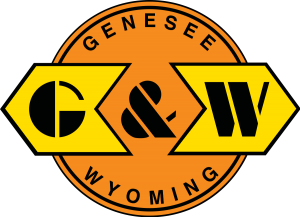 In 1977 Mortimer B. Fuller III, the great-grandson of the original owner, purchased G&W. Aside from family tradition, Fuller had a vision for the small railroad that went far beyond the borders of New York state. Genesee & Wyoming Industries was founded later that year, with the original railroad becoming its first subsidiary. Other divisions included GWI Leasing to facilitate rolling stock and locomotive leasing and fleet management; GWI Rail Management to provide service consulting and contract management of other short lines; and GWI Data Services to provide data and analytics for short line railroads, shippers, and freight car owners. Around the same time, the facilities at Retsof were expanded to take on additional contract business for freight car repair and repainting. In 1979 Fuller hired renowned graphic designer Milton Glaser to design the new G&W logo with its two large yellow arrows, one pointing to the past and the company’s legacy and the other pointed toward the future.
In 1977 Mortimer B. Fuller III, the great-grandson of the original owner, purchased G&W. Aside from family tradition, Fuller had a vision for the small railroad that went far beyond the borders of New York state. Genesee & Wyoming Industries was founded later that year, with the original railroad becoming its first subsidiary. Other divisions included GWI Leasing to facilitate rolling stock and locomotive leasing and fleet management; GWI Rail Management to provide service consulting and contract management of other short lines; and GWI Data Services to provide data and analytics for short line railroads, shippers, and freight car owners. Around the same time, the facilities at Retsof were expanded to take on additional contract business for freight car repair and repainting. In 1979 Fuller hired renowned graphic designer Milton Glaser to design the new G&W logo with its two large yellow arrows, one pointing to the past and the company’s legacy and the other pointed toward the future.
With the deregulation that followed passage of the Staggers Act in 1980, the big railroads began shedding unprofitable branch lines to new operators. In 1982 G&W acquired 14 miles of former Delaware, Lackawanna & Western main line between Greigsville (near Retsof) and Groveland, N.Y., from Conrail, doubling the size of the original line, and maintaining a connection to Dansville & Mt. Morris Railroad (which was also acquired by G&W in 1985). The new connection allowed Delaware & Hudson to establish an interchange through trackage rights, and a new dedicated route for salt deliveries to Northeastern cities. Additional interchanges were maintained with Chessie System at P&L Junction and Conrail at Caledonia, N.Y.
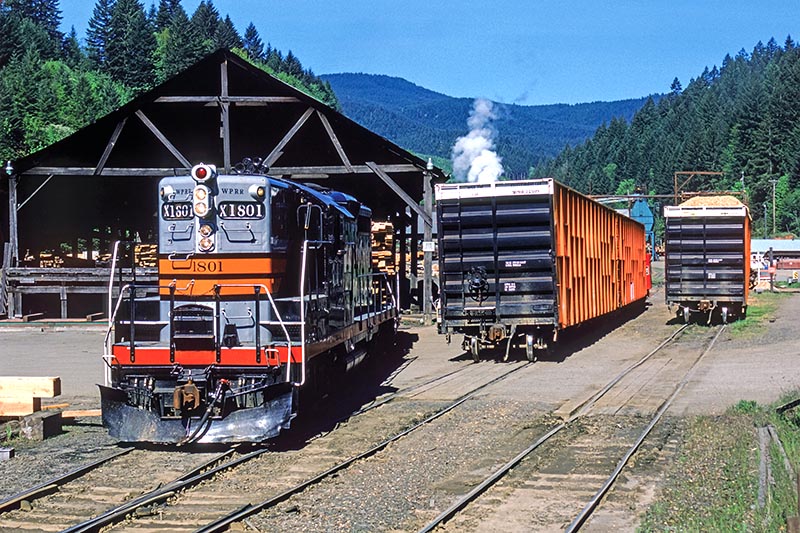
ABOVE: Willamette & Pacific “black widow” GP9 1801 (ex-SP 5830) switches out the Hull Oakes steam-powered sawmill at Dawson, Ore., in May 1997. The mill marked the end of the Bailey District in the Coast Range foothills. The shiny woodchip cars had been purchased from Southern Pacific for hauling woodchips to Georgia Pacific’s paper mill at Toledo. —Greg Brown photo
Genesee & Wyoming’s first step toward major expansion was made in July 1985 when they purchased 97 miles of B&O track (former Buffalo, Rochester & Pittsburgh) from Rochester to Ashford, N.Y., with rights to Salamanca. The D&H interchange was moved to Silver Springs. Rochester & Southern was formed in 1986 to operate this line; followed a few years later with the start-up of Buffalo & Pittsburgh in July 1988 on 255 miles of former B&O track from Buffalo through Ashford and down to Eidenau, Pa., with trackage rights to New Castle, Pa.
In between the expansion in western New York state, Genesee & Wyoming established a new operation 1,400 miles away on the Gulf Coast. Louisiana & Delta was formed in 1987 to operate a network of disconnected branch lines purchased from Southern Pacific. Headquartered in the old SP depot in New Iberia, La., the acquisition added 90 miles of new freight customers to the growing G&W empire.
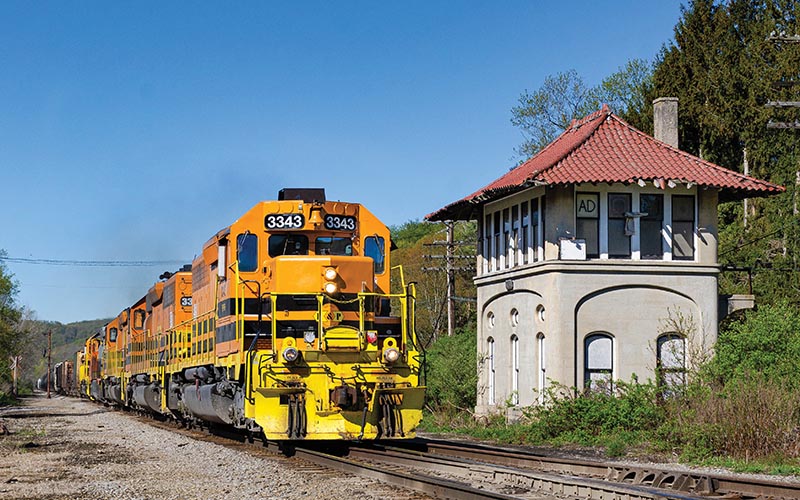
ABOVE: A northbound Buffalo & Pittsburgh train passes the abandoned Ashford Junction tower on May 12, 2021. This was historically where the former Buffalo, Rochester & Pittsburgh lines split to Buffalo and Rochester. The Rochester & Southern line was abandoned from Silver Springs south to Machias, N.Y., in 1991, severing the line from B&P. —Charles Rothbart photo
Crisis in Retsof
While the company was expanding its territory, operations on the original Genesee & Wyoming continued as they had for nearly 100 years (despite control of the salt mine passing from the Fuller family when International Salt was sold to Akzo Nobel in 1969). Then, on March 12, 1994, the unthinkable happened — what registered as a magnitude 3.6 earthquake centered around Cuylerville, N.Y., was actually a partial collapse of the salt mine at Retsof. Encompassing an underground area of more than 6,000 acres — nearly 10 square miles — subsequent underground flooding forced the shutdown of all mining operations by September 1995. Despite stockpiles of more than one million tons of salt, suddenly Genesee & Wyoming found itself without its largest customer.
In 1996 Akzo Nobel abandoned its plans to resume mining operations at nearby Hampton Corners and sold its rights to a consortium of businessmen who formed American Rock Salt in 1997. Construction of the new mine began in 1998 and was completed in 2001. Rochester & Southern constructed a new branch line off the former Lackawanna main line at Mount Morris to the new mine. Loading resumed in 2001, though by this time G&W was no longer dependent on a single commodity for survival…


